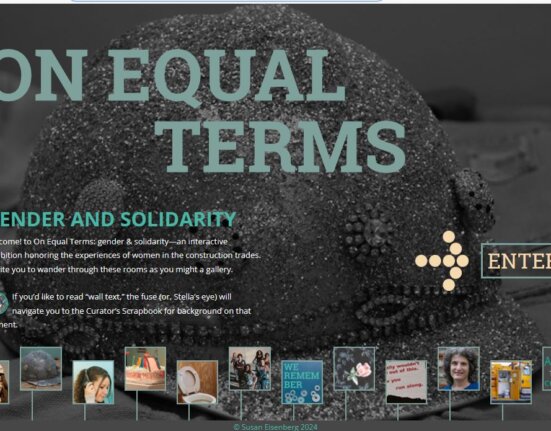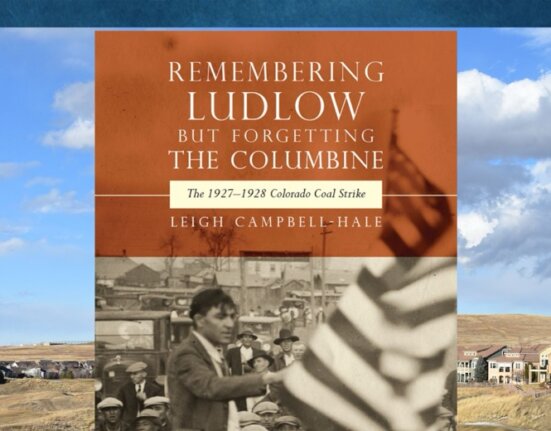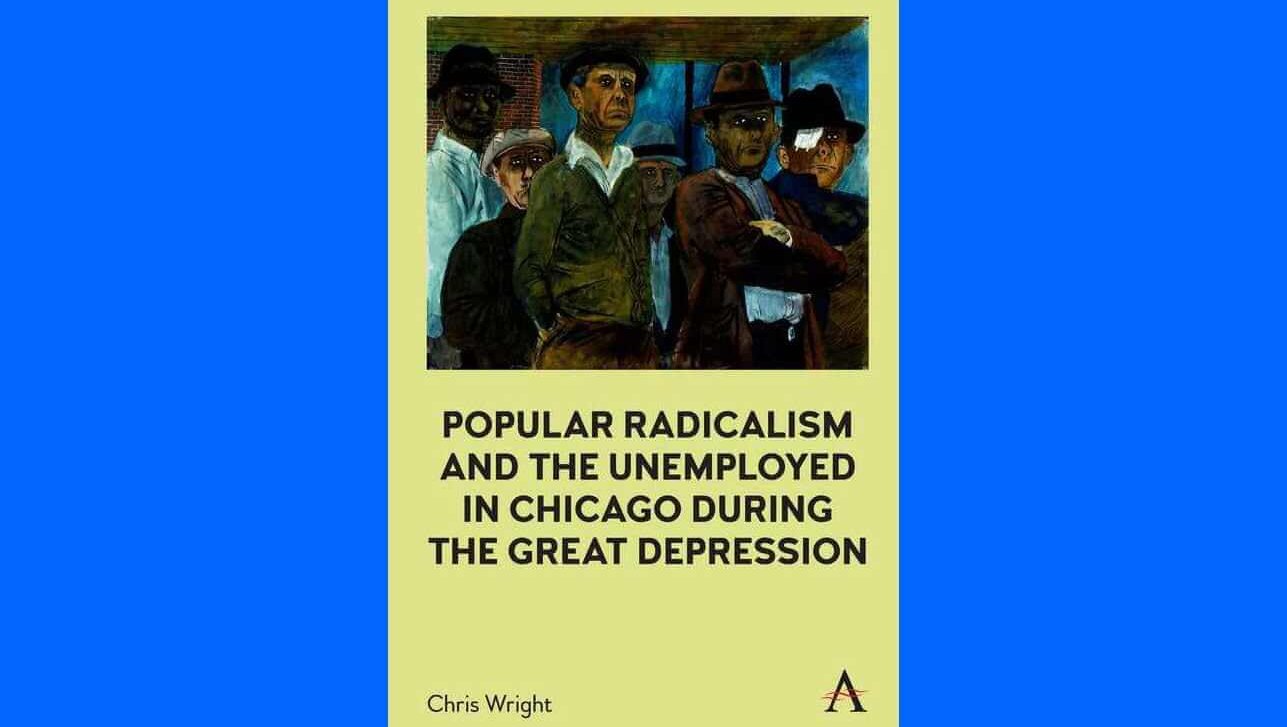I came in through the back entrance. It offered a clue to one strength of The Sweat of their Face: Portraying American Workers, an exhibition at the National Portrait Gallery, Washington, D.C. (through September 3 2018). Greeting me was Ramiro Gomez’s “Woman Cleaning Shower in Beverly Hills (after David Hockney’s Man Taking Shower in Beverly Hills, 1964)”. Gomez’s mother was a janitor; his painting was a meditation on her work, and his work as artist. A woman’s back confronts the viewer. Dressed in drab black and grey, her hair is pinned back for the job. She moves the squeegee downward along the shower wall. The cleaner is poised between standing and crouching, a precarious position, akin to her position in the labor market. Her worksite, the hotel room, is alive with color: teal shower tiles, a bubblegum pink carpet, and brightly colored furniture. Her dowdy garb, the pail, and plant are achromatic, as if Gomez establishes two worlds. Gomez’s title referenced Hockney’s male nude who showered. Hockney’s figure enjoys a respite, but Gomez reminds us of who maintains such refuges, underscoring labor’s invisibility. This painting’s backdoor location signals an exhibition conscious of educating visitors about multiple forms of labor, including the care labor and reproductive labor that have often been women and people of color’s domain.
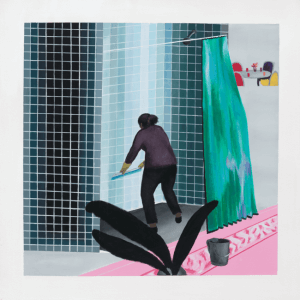
In contrast, the exhibition’s entry features a paean to virtuous (white and masculine) labor, John Neagle’s monumental portrait of antebellum blacksmith, “Pat Lyon at the Forge.” Lyon commissioned Neagle to paint him “at work at my anvil…with my sleeves rolled up and a leather apron on.” Lyon’s forearm as he grabs his hammer is the canvas’s focal point, and light falls upon the implements of his trade, strewn as if he is in a whirlwind of work. Lyon, however, stands still and proud while appraising the viewer; he is subordinate to no one. In the canvas’s upper left corner lies Philadelphia’s Walnut Street Jail where Lyon had been falsely convicted and imprisoned for debts. Lyon purposefully had himself portrayed as a republican artisan who embraces manual labor, rejecting the owning classes’ status and chicanery. Neagle encapsulated an American ideal of the proud worker, critical to the nation’s democratic project, where work and independence are intertwined and rewarded with full citizenship. As the show’s superb catalog explains, in the canvas, “masculine work was in the service of nation-building.” (9) Lyon’s portrait was unusual as portraiture is traditionally considered a dialogue or navigation between the sitter and the artist. The privilege of sitting belonged to elites who were to be emulated and who could pay the commission. Lyon could be self-made in his social status, and in his representation, but industrial capitalism would soon make such image control financially difficult for most workers, according to the curators.
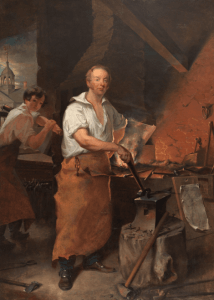
In between the anonymous cleaner and the virile heroic craftsman, The Sweat of Their Face charts a complex portrait of labor from the Revolutionary era through today, across multiple media. The exhibition is packed with familiar images such as Winslow Homer’s agricultural and industrial workers, A.J. Russell’s photograph of the joining of the transcontinental rail lines, Lewis Hine’s tenacious child laborers, Dorothea Lange’s “Migrant Mother,” Gordon Parks’s Ella Watson, the black Washington D.C. charwoman immortalized in a pose akin to Grant Wood’s “American Gothic,” and J. Howard Miller’s “Rosie the Riveter.” Curators also feature many lesser known gems. The late eighteenth-century watercolor of the enslaved “Miss Breme Jones,” painted by her master, shows a substantial woman delicately rendered; the “occupational” daguerreotype, Marie Boyd, (Holding a Weaving Shuttle) shows a serene woman in a flamboyant print dress, holding the tools of her trade; Francis Hyman Criss’s “Alma Sewing” for the New Deal Federal Arts Project displays an elegant black woman at her machine; the cluttered canvas includes cloth swatches, seamstress form, doll, and the artist’s own reflected self-portrait, a nod to the artist’s allegiance to labor. Edward Weston’s photograph of a cement worker’s glove provides the trace of the laborer who wore it. In Pirkle Jones’s “Grape Picker, Berryessa Valley, California,” the migrant worker holds out the grapes in invitation. His enigmatic expression suggests the costs of harvesting California’s cornucopia. In contrast, Sam Comen’s incandescent “Almond Poling Crew During Harvest Near Lost Hills, Ca. September 16, 2009,” shows a migrant brigade, their poles upright. The laborers stare implacably at the viewer, their poles weapons in a war of class and nation. Dawoud Bey celebrates a New York City barber, and Shauna Frischkorn’s “Sean, Subway Sandwich Artist,” envelopes her fast food worker in a black velvety background, akin to a Flemish painting, while the sandwich artist stares pointedly back at viewers.
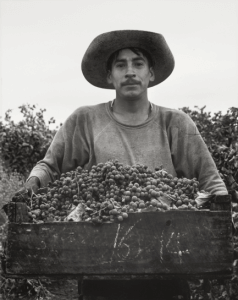
The exhibition subverts traditional perspectives on the question of who labors. Whose work is rewarded with citizenship, whose work is recognized as building the nation, whose work is even seen? Many images depict care work: servants and mothers who care for their charges, African, Mexican, and Asian Americans who cook, white fast food workers, black seamstresses, black janitors and charwomen. Simultaneously, the exhibition identifies the ideological work of visual culture. “African American Woman with Two White Children” (ca. 1860) shows a well-dressed black woman. She is self-contained, her hands folded upon one another on her lap. As with most early photography, the sitter’s expression is stern, but the children who lounge against her testify to her care work. This portrait identifies the gender and race-based labor segmentation that has persisted for more than two centuries at this point, with women of color caring for white charges. The photograph also documents multiple forms of coercion. She minds these children as an enslaved woman, but she is also the subject of coerced labor within the ideological frame, as her master casts her within the contours of a family portrait. Many of the works challenge by indicating the erasure of labor. In Winslow Homer’s “Old Mill, The Morning Bell” (1871), delicate New England farm girls head to the factory in a sun-kissed canvas. The scene in is so bucolic, work is hidden, as is the then new waged-labor industrialism.

The curators, curator of painting and sculpture Dorothy Moss and historian emeritus David C. Ward, must be applauded for their rich display of labor, but they haven’t quite dislodged the stereotype of an aristocracy of labor that is white and male. The largest grouping in the exhibition show white men engaged in artisanal or industrial labor. In addition to Pat Lyon, we see Timothy O’Sullivan’s photographs of underground miners, Lewis Hine’s agile Empire State Building workers, Ben Shahn’s paintings of carpenters and welders, Norman Rockwell’s “Mine America’s Coal,” and Yousef Karsh’s Hollywood-like steel and autoworkers.
One artistic form, genre painting, or painting of everyday life has long been identified with workers. The neo-Marxist art critic, John Berger, argues in Ways of Seeing that genre paintings were designed to flatter the owner-commissioner by asserting, “that the poor are happy, and that the better-off are a source of hope for the world.” The Sweat of Their Face displays Lilly Martin Spencer’s “The Jolly Washerwoman,” a buxom, smiling maid whose gum-exposing grin is intended to engage, even as her arms prop her body up upon the tub. The curators see her as “in command.” Spencer supported her husband and thirteen children though such genre paintings; did not the market contribute to Spencer’s evocation of ebullient labor? Similarly, Thomas Waterman Wood’s portrait of the butler, Charles Wilson Fleetwood, Jr. was commissioned for Fleetwood’s employer, John C. Brune. Fleetwood’s pose is “dignified” according to the curators. Fleetwood’s smile suggests his desire to serve, which may suit the patron and artist more than the subject.
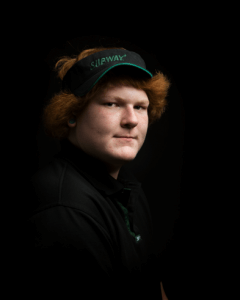
A final observation on The Sweat of their Face is that workers are seen, or a subject of sight. rather than consciously fashioning their own image, as did Pat Lyon. The curators acknowledge this tension in labor’s representation. Women are similarly represented. John Berger argued “Men act; women appear,” in most art. Feminist visual studies scholar Laura Mulvey described a “male gaze,” that empowers the viewer, and disempowers the object of sight. Workers, like women, seem available to our gaze—how many gaze back at us, how many engage with one another, how many join a larger collective whole, or protest their status? Yes, the “Subway Sandwich Artist” connects with a keen stare, Ella Watson reproaches, with her mild, but direct stance, and the antebellum Bowery B’hoy purposefully displays himself. A few engage in a labor so dynamic it seems to break out of the two dimensional frame, such as Theodore Roszaks, “Study of Man Sewing” or Jacob Lawrence’s “Cabinet Maker.” But many of these workers seem quiescent—ennobled, but simultaneously inert. Have artists failed to capture the dynamic consciousness of individual workers or more importantly, their collective efforts? In choosing genre painting over occupational tintypes or vernacular photography, did curators contribute to a view of workers as essentially passive? It is ironic that workers, certainly not docile, are in too many instances not fully present, even at their own show.





